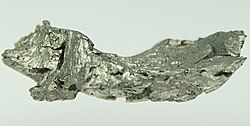Gadolinium
Gadolinium metal possesses unusual metallurgic properties, to the extent that as little as 1% gadolinium can significantly improve the workability and resistance to high temperature oxidation of iron, chromium, and related alloys. Gadolinium as a metal or salt has exceptionally high absorption of neutrons and therefore is used for shielding in neutron radiography and in nuclear reactors. Like most rare earths, gadolinium forms trivalent ions which have fluorescent properties. Gd(III) salts have therefore been used as green phosphors in various applications.
The Gd(III) ion occurring in water-soluble salts is quite toxic to mammals. However, chelated Gd(III) compounds are far less toxic because they carry Gd(III) through the kidneys and out of the body before the free ion can be released into tissue. Because of its paramagnetic properties, solutions of chelated organic gadolinium complexes are used as intravenously administered gadolinium-based MRI contrast agents in medical magnetic resonance imaging. However, in a small minority of patients with renal failure, at least four such agents have been associated with development of the rare nodular inflammatory disease nephrogenic systemic fibrosis. This is thought to be due to the gadolinium ion itself, since Gd(III) carrier molecules associated with the disease differ.
Occurrence
Gadolinium is a constituent in many minerals such as monazite and bastnäsite, which are oxides. The metal is too reactive to exist naturally. Ironically, as noted above, the mineral gadolinite actually contains only traces of Gd. The abundance in the earth crust is about 6.2 mg/kg. The main mining areas are China, USA, Brazil, Sri Lanka, India and Australia with reserves expected to exceed one million tonnes. World production of pure gadolinium is about 400 tonnes per year.
| Symbol | Gd | |
| Atomic Number | 64 | |
| Atomic Weight | 157.25 | |
| Oxidation States | +3 | |
| Electronegativity, Sanderson | 0.94 | |
| State at RT | Solid, Metal | |
| Melting Point, K | 1586 | |
| Boiling Point, K | 3539 |
Appearance and Characteristics
Harmful effects:
Gadolinium is considered to be moderately toxic.
Characteristics:
- Gadolinium is a bright, soft, silvery-white metal that is both ductile and malleable.
- It is one of the rare earth metals.
- It does not react in dry air but will tarnish to a flaky white oxide in moist air that does not protect it from further oxidation.
- The metal reacts slowly with water and is soluble in dilute acid. It produces colorless salts.
- When present in compounds, gadolinium exists mostly in the trivalent state (Gd3+).
- At room temperature the metal is paramagnetic, but it becomes ferromagnetic (strongly attracted by a magnet) when cooled. The Curie point of gadolinium is 17 oC. (2)
- The 157Gd isotope has the highest thermal neutron capture cross-section of any known stable element.
Uses of Gadolinium
- Gadolinium is used in alloys of iron and chromium to improve resistance to high temperatures and oxidation.
- Gadolinium is used to make gadolinium yttrium garnets which have microwave applications.
- Gadolinium compounds are used as green phosphors in color television picture tubes.
- Because of its magnetic properties, gadolinium is also used in intravenous radiocontrast agents in magnetic resonance imaging (MRI).
- Arc-melted alloys of gadolinium, silicon, and germanium demonstrate a strong magnetocaloric effect at room temperatures (where its temperature increases when it enters a magnetic field and decreases when it leaves the magnetic field) making it useful in the field of room temperature magnetic refrigeration.
